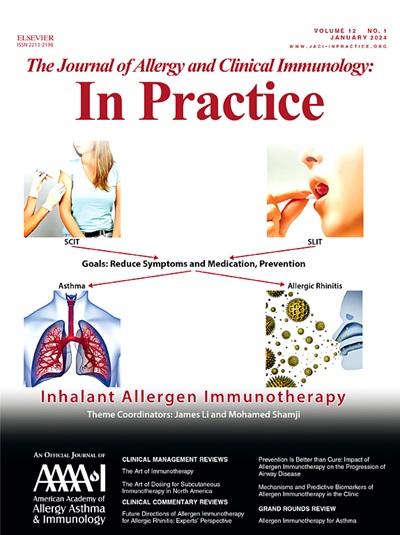非典型感冒性荨麻疹的亚型及其诊断检查建议。
IF 6.6
1区 医学
Q1 ALLERGY
Journal of Allergy and Clinical Immunology-In Practice
Pub Date : 2025-09-01
DOI:10.1016/j.jaip.2025.07.019
引用次数: 0
摘要
背景:有相当一部分患有冷性荨麻疹(ColdU)的患者具有非典型的疾病表现,并在现实环境中出现冷致荨麻疹和/或血管性水肿,但在标准冷刺激试验(CSTs)中没有反应。如何诊断非典型ColdU在很大程度上是不清楚的,而且对临床特征和治疗反应知之甚少。目的:本研究的目的是描述非典型ColdU的亚型,并为诊断提供建议。方法:我们对非典型ColdU亚型进行了全面的文献检索,并公布了检测方法。然后,我们开发并试点了针对8种非典型ColdU亚型的改良冷刺激试验(mCSTs)。结果:我们的系统综述确定了10种非典型ColdU亚型,即延迟性ColdU、异常轮状ColdU、延长暴露性ColdU、全身暴露性ColdU、局部ColdU、冷致胆碱能性荨麻疹、冷依赖性皮肤特征、水依赖性ColdU、食物依赖性ColdU和超冷冻型ColdU。诊断性mCSTs方案的试点测试在8个变体中有8个获得成功。基于这些结果,我们对已知非典型ColdU亚型的诊断检查提出了建议。结论:mCSTs为疑似非典型ColdU患者提供了更精确的诊断确认,允许在整个病程中进行有效监测,促进获得特定治疗方案,并最终改善对该患者群体的护理。本文章由计算机程序翻译,如有差异,请以英文原文为准。
Subtypes of Atypical Cold Urticaria and Recommendations for Their Diagnostic Workup
Background
A substantial subset of patients suffering from cold urticaria (ColdU) have atypical disease presentations and develop cold-induced wheals and/or angioedema in a real-world setting but not in response to standard cold stimulation tests. How to diagnose atypical ColdU is largely unclear, and little is known about the clinical features and treatment responses.
Objective
The aim of the study was to describe subtypes of atypical ColdU and provide recommendations for the diagnostic workup.
Methods
We conducted a comprehensive literature search on subtypes of atypical ColdU and published testing procedures. We then developed and pilot-tested modified cold stimulation tests (mCSTs) for 8 subtypes of atypical ColdU.
Results
Our systematic review identified 10 subtypes of atypical ColdU—delayed ColdU, ColdU with aberrant wheals, extended exposure ColdU, generalized exposure ColdU, localized ColdU, cold-induced cholinergic urticaria, cold-dependent dermographism, water-dependent ColdU, food-dependent ColdU, and ultra-freeze ColdU. Pilot-testing of protocols for diagnostic mCSTs was successful in 8 of 8 variants. Based on these results, we generated recommendations for the diagnostic workup of known subtypes of atypical ColdU.
Conclusions
The mCSTs provide a more precise diagnostic confirmation in patients with suspected atypical ColdU and allow effective monitoring throughout the disease course, facilitating access to specific therapy options, and ultimately leading to improved care for this patient population.
求助全文
通过发布文献求助,成功后即可免费获取论文全文。
去求助
来源期刊

Journal of Allergy and Clinical Immunology-In Practice
ALLERGYIMMUNOLOGY-IMMUNOLOGY
CiteScore
11.10
自引率
9.60%
发文量
683
审稿时长
50 days
期刊介绍:
JACI: In Practice is an official publication of the American Academy of Allergy, Asthma & Immunology (AAAAI). It is a companion title to The Journal of Allergy and Clinical Immunology, and it aims to provide timely clinical papers, case reports, and management recommendations to clinical allergists and other physicians dealing with allergic and immunologic diseases in their practice. The mission of JACI: In Practice is to offer valid and impactful information that supports evidence-based clinical decisions in the diagnosis and management of asthma, allergies, immunologic conditions, and related diseases.
This journal publishes articles on various conditions treated by allergist-immunologists, including food allergy, respiratory disorders (such as asthma, rhinitis, nasal polyps, sinusitis, cough, ABPA, and hypersensitivity pneumonitis), drug allergy, insect sting allergy, anaphylaxis, dermatologic disorders (such as atopic dermatitis, contact dermatitis, urticaria, angioedema, and HAE), immunodeficiency, autoinflammatory syndromes, eosinophilic disorders, and mast cell disorders.
The focus of the journal is on providing cutting-edge clinical information that practitioners can use in their everyday practice or to acquire new knowledge and skills for the benefit of their patients. However, mechanistic or translational studies without immediate or near future clinical relevance, as well as animal studies, are not within the scope of the journal.
 求助内容:
求助内容: 应助结果提醒方式:
应助结果提醒方式:


